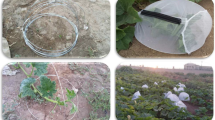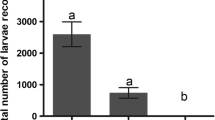Abstract
Field survey showed that the fungusBeauveria bassiana Vuillemin was the predominant natural enemy ofSitona discoideus Gyllenhal larvae and pupae in the Mediterranean region. The present area of distribution of the disease does not, however, include the parts of North Africa, Cyprus, Syria and Iraq with a Mediterranean climate. At localities regularly investigated in southern France over the period 1973–79, the population dynamics of larvalSitona on volunteerMedicato species appeared to be correlated to some extent with the impact of the fungal disese, which could produce up to 100% mortality on its host larval populations.
Several isolates of the pathogen were tested in laboratory bioassays to determine their potential activity. One accession from southern France proved particularly virulent toS. discoideus larvae and pupae at the relatively low concentration of 105 conidia/g of soil. This accession seemed worth considering for further quarantine testing and introduction into Australia. Differences between isolates were however confounded by varying ages of the cultures involved.
Résumé
Les recherches entreprises de 1973 à 1984 ont montré que le champignon entomophatogèneBeauveria bassiana Vuillemin était largement répandu sur larves deSitona spp. en rǵeion méditerranéenne. Il y fait toutefois défaut (tableau 2) dans les zones pastorales d'Afrique du Nord, de Chypre, de Syrie et d'Irak. La mortalité larvaire due à cette mycose parait en mesure d'influencer l'évolution dynamique des populations deSitona discoideus Gyllenhal (tableau 3). En effet,B. bassiana est susceptible d'affecteur jusqu'à 100% des larves deS. discoiduus s'attaquant aux dieverses espèces deMedicago, suivant les sites considérés en France méditerranéenne.
Lors de tests en laboratoire une souche méridionale deB. bassiana s'est révélée paritculièrement infectieuse à des doses relativement faibles, de l'ordre de 105 conidies par gramme de terre (tableau 4). Une telle virulence perment d'envisager d'éventuelles applications de plein champ contreS. discoideus en Australie méridionale. Une expérimentation plus détaillée est`a prévoir, qui devra cependant tenir compte d'un affaiblissement graduel du pouvoir infectieux des isolats au cours de leur conservation en mycothéque.
Similar content being viewed by others
References
Aeschlimann, J. P. — 1979. Sampling methods and construction of life tables forStiona humeralis populations [Col., Curculionidae] in Mediterranean climatic areas. —J. Appl. Ecol., 16, 405–415.
Aeschlimann, J. P. — 1980. TheSitona [Col.: Curculionidae] species occurring onMedicago and their natural enemies in the Mediterranean region. —Entomophaga,25, 139–153.
Aeschlimann, J. P. — 1983. Sources of importation, establishment and spread ofMicroctonus aethio-poides Loan [Hymenoptera: Braconidae], a parasitoid ofSitona discoideus Gyllenhal [Coleoptera: Curculionidae]. —J. Aust. Entomol. Soc., 22, 325–331.
Allen, P. G. — 1971.Sitona humeralis Steph. [Coleoptera: Curculionidae] in South Australia. —Rep. Dep. Agric. S. Aust. Agron. Branch, 36, 1–13.
Allison, J. L. — 1949. Natural control of the destructive sweet-clover weevilSitona cylindricollis Fabr. by an entomogenous fungus parasites. —Phytopathology, 39, 501.
Benz-Ze'ev, I. &Kenneth, R. G. — 1980.Zoophthora phytonomia andConidiobolus osmodes [Zygomyctes: Entomophtooraceae], two pathogens ofHypera species [Col., Curculionidae] coincidental in time and place. —Entomophaga, 25, 171–186.
Bird, R. D. — 1949. Studies on the biology and control of the sweetclover weevil [Coleoptera: Curculionidae] in Manitoba, 1945–1949. —Rep. Entomol. Soc. Ont., 80, 31–36.
Burgerjon, A. — 1956. Pulvérisation et popudrage au laboratoire par des préparations pathogènes insecticides. —Ann. Epiphyt., 4, 677–686.
Cullen, J. M. &Hopkins, D. C. — 1982. Rearing, release and recovery ofMicroctonus aethiopoides Loan [Hymenoptera: Braconidae] imported for the control ofSitona discoideus GyllenhalColeoptera: Curculionidae] in south eastern Australia. —J. Aust. Entomol. Soc., 21, 279–284.
Danthanarayana, W. — 1969. Population dynamics of the weevilSitona regensteinensis (Hbst.) on broom. —J. Anim. Ecol., 38, 1–18.
Ellingboe, A. H., Kernkamp, M. F. &Haws, B. A. — 1957. Sweetclover weevil parasitized byBeauveria bassiana (Bals.) Vuill. in Minnesota. —J. Econ. Entomol., 50, 173–174.
Ferron, P. — 1978. Biological control of insect pests by entomogenous fungi. —Annu. Rev. Entomol., 23, 409–442.
Fisher, J. R. — 1977. The population dynamics of the pea leaf weevilSitoria lineatus (L.) in Northen Idaho and Eastern Washington. —Phd. thesis, Univ. Idaho, 1–180.
Gafurova, V. L. — 1974. The effect of boverin on the lucerne weevil. —Zashchita Rastenii, 6, 26.
Grigorov, S. P. — 1956. Les espèces du genreSitona Germ. en Bulgarie. —Nauchni Trud. Vissh Selskostop. Inst. Georgi Dimitrov (Agron. Facult.), 3, 325–434.
Herron, J. C. — 1953. Biology of the sweetclover weevil and notes on the biology of the clover root curculio. —Ohio J. Sci., 53, 103–112.
Hopkins, D. C. & Cullen, J. M. — 1985. The rearing, release and recovery ofPatasson lameerei Debauche [Hymenoptera: Mymaridae], a parasite imported for the control ofSitona discoideus Gyllenhal [Colleoptera: Curculionidae] in Australia.J. Aust. Entomol. Soc., 24.
Kilpatrick, R. A. — 1961. Fungi associated with larvae ofsitona spp. —Phytopathology, 51, 640–641.
Müller-Kögler, E. &Stein, W. — 1970. Gewächschausversuche mitBeauveria bassiana (Bals.) Vuill. zur Infektion vonSitona lineatus (L.) [Colept., Curcul.] im Boden. —Z. Angew. Entomol., 65, 59–76.
Müller-Kögler, E. &Stein, W. — 1976. Gewächschausversuche mitMetarrhizium anisopliae (Metsch.) Sorok zur Infektion vonSitona lineatus (L.) [Col.: Curculionidae] im Boden. —Z. Pfl. Krankh. Pfl. Schutz, 83, 96–108.
O'Keefe, L. F. & Homan, H. W. — 1979. The pea leaf weevil.Univ. Idaho Agric. Exp. Stat., Curr. Inform., 227, 2 pp.
Owen, D. F. — 1955. Coleoptera taken by swifts (Apus apus L.). —J. Soc. Br. Entomol., 5, 105–109.
Prescott, H. W. &Reecher, M. M. — 1961. The pea leaf weevil an introduced pest of legumes in the Pacific Northwest. —USDA Agric. Res., Tech. Bull., 1233, 1–12.
Robert, P. &Marchal, M. — 1980. Utilisation des larves dePlutella maculipennis [Lep.: Hyponomeutidae] comme insecte-test de divers hyphomycètes entomopathogènesFungi Imperfecti. —Entomophaga, 25, 83–89.
Rybchin, V. E. — 1982. Enemies of root-nodule weevils. —Zaschchita Rastenii, 2, 30–31.
Sapunaru, T. — 1975. Cercetäri asupra morfologièi, biologiei, ecologiei si combatterii speciilorSitona crinitus Herbst siSitona lineatus L —Doct. Agron. Thesis, Fac. Agron., Bucuresti, 1–21.
Tate, P. — 1940. OnMycetosporidium jacksonae n. sp. parasitic in species ofSitona weevils. —Parasitology, 32, 462–469.
Wightman, J. A. — 1980.Sitona humeralis in the South Island of New Zealand. In: Proc. 2nd Australas. Conf. Grassl. Invert. Ecol., 5th sess. (T. K. Crosby &R. P. Pottinger ed.). —Govern. Printer, Wellington, 138–141.
Wood, J. — 1980. Notes on the sitona weevil,Sitonà humeralis [Coleoptera: Curculinoidae], a pest of lucerne in Canterbury. —N.Z. Entomol., 7, 169–171.
Author information
Authors and Affiliations
Rights and permissions
About this article
Cite this article
Aeschlimann, J.P., Ferron, P., Marchal, M. et al. Occurrence and pathogenicity ofBeauveria bassiana infesting larvalSitona discoideus [Col.: Curculionidae] in the Mediterranean region. Entomophaga 30, 73–82 (1985). https://doi.org/10.1007/BF02372286
Received:
Accepted:
Issue Date:
DOI: https://doi.org/10.1007/BF02372286




